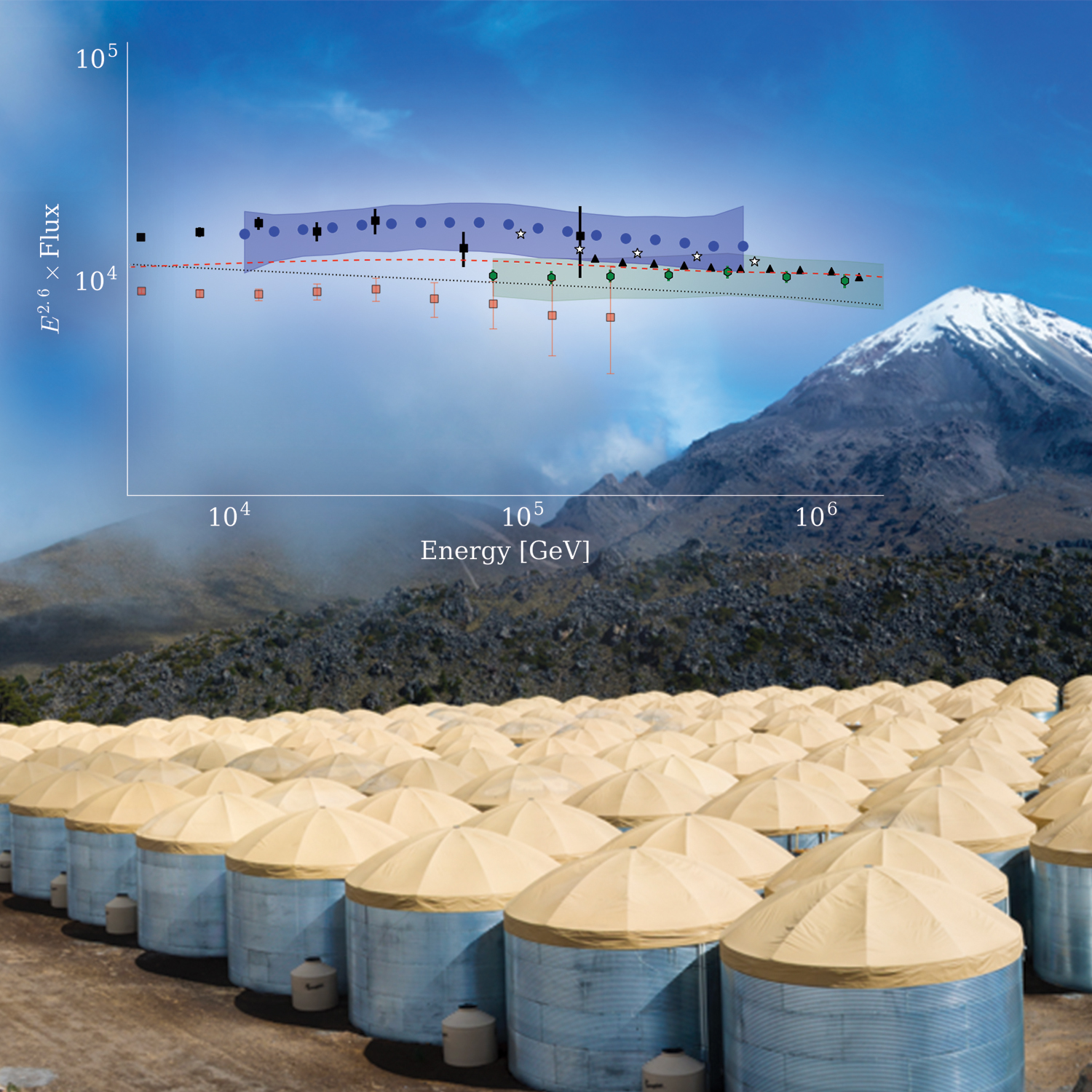Understanding the nature and origin of cosmic rays is a major goal of modern astrophysics and one that the High-Altitude Water Cherenkov (HAWC) Observatory is committed to contribute to. In a study published today in the journal Physical Review D, HAWC announces a measurement of the cosmic-ray energy spectrum in the energy range of 10 to 500 TeV, bridging measurements at higher energy usually performed by ground based detectors and measurements at lower energy that previously had been conducted by detectors on satellites and balloons.

“With this first measurement, HAWC reveals fine structure in the cosmic-ray energy spectrum at the TeV scale,” explains Zig Hampel-Arias, who worked on this analysis at WIPAC for his UW–Madison PhD. “Understanding the origin of this structure will tell us more not only about the sources of cosmic rays, such as supernova remnants, but also about the galactic environment in which these particles travel to reach us.”
Cosmic rays are protons or other atomic nuclei created in astronomical sources throughout the universe. They are very abundant and have been studied by many detectors during the last century. By deciphering their properties, scientists hope to learn more about the sources that produce them, but also about the magnetic fields they cross on their travels through the galaxy.
Before reaching Earth’s surface, cosmic rays are stopped by the atmosphere, creating a shower of secondary particles that can span several kilometers when they land and that are absorbed in the first few kilometers of the crust. To detect these particles, HAWC uses 300 huge water tanks covering an area equivalent to four football fields and placed at high altitude on the slopes of the Sierra Negra volcano, near Puebla in Mexico.
When the particles of the cosmic-ray shower enter a tank, filled with 188,000 liters of purified water—1,000 times the capacity of a bathtub, they create a flash of blue light. At the bottom of these tanks, four sensors measure the light. The light recorded in all the tanks as a function of time creates a movie of the cosmic-ray shower passing through the HAWC array.
“The shower of secondary particles reaches the detector in a thin pancake, and the relative timing of when this pancake hits each detector and the amount of light we see in each tank lets us reconstruct the arrival direction and the energy of each shower,” explains Prof. Stefan Westerhoff, principal investigator of the HAWC group at WIPAC and a professor of physics at UW–Madison.
HAWC detects two billion cosmic-ray showers every day, but each one is different. Some impact the detector from straight above the array, while others reach the array with a skewed pattern that indicates that the cosmic ray did not penetrate the atmosphere perpendicularly. Some showers leave only small amounts of light, while others light almost every sensor of the array.
In this study, WIPAC researchers used cosmic-ray particles reaching HAWC from almost perpendicular showers and with the shower core landing on the array. For those events, they measured how the rate changes as a function of the energy. This is what scientists call the energy spectrum.
Inferring the energy of a cosmic ray from the light produced by the shower of secondary particles in a huge array like HAWC is not an easy task. But the Moon shadow comes in handy. The Moon blocks cosmic rays on their way to Earth, creating a shadow that is shifted with respect to its real position due to Earth’s magnetic field. Cosmic rays at different energies will bend in a different way, allowing researchers to calibrate both the angular resolution and the energy-light response of the HAWC array.
This first measurement of the cosmic-ray energy spectrum by HAWC spans the domains of direct and indirect detection techniques, and results are in good agreement with previous measurements from detectors both on the ground and on satellites and balloons. But the spectrum shows an interesting feature at an energy around 45 TeV.
It is well known that the rate of cosmic rays decreases with energy, and that this dependence shows a fairly abrupt change at energies around 3,000 TeV and again at energies around three million TeV, which are considered to mark the beginning and the end of the transition from cosmic rays created in galactic and extragalactic sources.

What HAWC scientists have found is a smaller, but significant, change in the spectrum between cosmic rays with energies from 10 to 45 TeV and those above 45 TeV. This feature, which has already been spotted by other detectors, albeit with insufficient significance, could be due to variations in the composition of the cosmic rays, most likely proton and helium nuclei at these energies.
“Indeed, this is a very interesting feature that can help constrain models of particle acceleration and interstellar magnetic fields,” explains Hampel-Arias.
The HAWC observatory was completed in 2015 and is run by an international collaboration of about 120 people in 30 institutions in Mexico, the US, and Europe. Efforts by the WIPAC group are supported by the National Science Foundation and the Wisconsin Alumni Research Foundation. HAWC is exploring the high-energy universe in gamma rays and is also a very sensitive detector for cosmic rays from a few TeV up to a few PeVs, which allows for precise measurement of the cosmic-ray anisotropy and improved measurements of the cosmic-ray flux.
+ info “All-particle cosmic ray energy spectrum measured by the HAWC experiment from 10 to 500 TeV,” HAWC Collaboration: R. Alfaro et al. Phys. Rev. D 96, 122001 (2017). DOI: 10.1103/PhysRevD.96.122001 (featured as editor’s suggestion)
